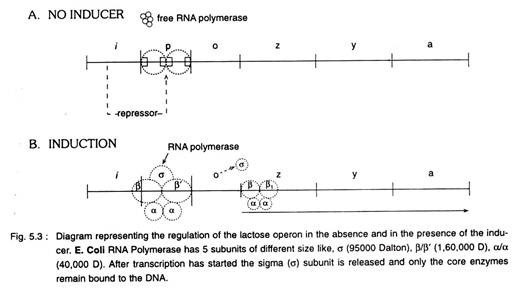ADVERTISEMENTS:
In this article we will discuss about the properties of lac operon. Also learn about the role of cyclic AMP in lac operon.
i) Products of all genes are transcribed in a single mRNA, called polygenic or polycistronic, starting from single promoter site.
ii) mRNA of lac operon mol wt. 1.7 x 106 daltons is far greater than the need for coding β-galactosidase alone. This polygenic mRNA may have several start points e.g., AUG.
ADVERTISEMENTS:
iii) Polarity may be explained by:
(a) Excess production of operator proximal mRNA.
(b) Several start points.
(c) Tetrameric nature of these enzymes.
ADVERTISEMENTS:
(d) Very little requirement of M protein (permease), selected by natural selection;
(e) Nonsense mutations in promoter proximal portion exert polar effect on the distal genes.
iv) In the presence of an inducer (suitable metabolite) the repressor is inactivated and the operator becomes free. In this condition the entire operon may be transcribed by the RNA polymerase.
v) Regulation of the lac operon is by way of the repressor which binds to the operator, thereby interfering with the transcription by RNA polymerase. In this condition the lac operon is inactive and no enzymes are produced.
vi) E. coli grow on carbon source other than lactose the intracellular level of enzymes from z, y and a is 10-3 times that when lactose is present. The lactose possess invariably de novo synthesis of enzyme.
Cells grow in presence of radioactive amino acids (but no lactose) for several generations and later transferred after a thorough washing into a nonradioactive lactose containing medium (amino acids are not radioactive) show unlabelled galactosidase from 3 minutes onWard .This supports the de novo synthesis concept of β-galactosidase.
Role of Cyclic AMP in Lac Operon:
The lac operon also has a positive control mechanism provided by cAMP, which interacts with a receptor protein (CRP). The CRP- cAMP complex binds to the promoter; thus allowing the RNA polymerase to recognize the promoter.
ADVERTISEMENTS:
When cAMP levels are low (i.e., when cells are grown in glucose), β-galactosidase levels will decrease, by a phenomenon known as catabolite repression. Crombrugghe et al, (1971) concluded that the lac promoter was a double site, one part for the binding of RNA polymerase and the other for the action of cyclic AMP and its receptor protein.
Glucose, or more strictly a glucose break-down product (catabolite) lowers the cyclic AMP level and so prevents the activation of catabolite sensitive genes.
Mutants of E. coli that cannot synthesize cAMP (i.e., that lack adenylcyclase) can grow on a glucose substrate. Catabolite repression is reversed, upon addition of exogenous cAMP specifically to a segment of the DNA known as the lac operator, which is composed of 12 to 15 nucleotides .Each of the subunits of the repressor has one binding site for the inducer.
The natural inducer of the Lac operon is lactose. Experimentally, it is much better to use an artificial inducer such as isopropylthio- galactoside (IPTG), which without further change binds to the repressor and acts, as an inducer. Upon binding of IPTG, the repressor undergoes a conformational change by which it becomes unable to bind to the operator, thus inducing the transcription of lac operon.

